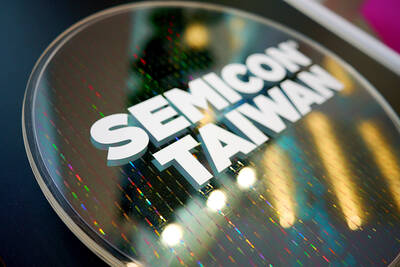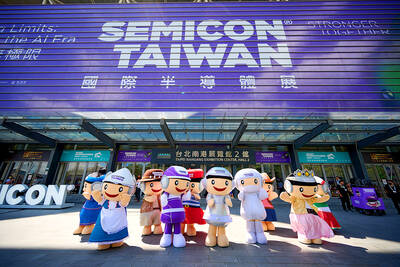For consumers who dream of having a flat-screen television mounted on their wall but are restrained by a tight budget, the emergence of more price-friendly liquid crystal on silicon (LCOS) TVs may bring them closer to realizing that dream.
LCOS is a projection-TV technology which promises lighter, brighter and thinner sets than conventional rear-projection TV's.
A 50-inch LCOS-TV from Taiwan Kolin Co (
The Taiwanese home-appliance maker first unveiled its LCOS-TV at the Taipei International Electronics Exhibition last year and started commercial production in August, aiming to re-establish the company as the No. 1 TV supplier in Taiwan.
Local rival Sanyo Electric Co (Taiwan) (
Both Kolin or Sanyo are using the lower prices of LCOS-TVs to compete with plasma display panel (PDP) and liquid crystal display (LCD) TVs.
"To get an LCOS set, you only have to pay about half the price of an LCD-TV of similar size," said Frank Lee (
The emergence of LCOS-TVs in the local flat-panel market is a result of close cooperation between Taiwanese home-appliance makers and the world's two largest made-to-order chipmakers, Taiwan Semiconductor Manufacturing Co (TSMC,
Kolin uses TSMC's chips for its LCOS sets, while Sanyo uses UMC's.
Teco Electric & Machinery Co (東元電機), Taiwan's second-largest home-appliance maker, also plans to roll out its first LCOS-TV next year using chips from Thinktek Optronics Corp (寬柏光學), said Frank Wu (吳宏庭), Teco's executive of the consumer appliance and services sector. Wu said the company is waiting for more mature technologies before it rolls out its new sets.
"The biggest technological barrier to producing LCOS sets is resolution. And I don't think the technologies are ready now," Wu said.
Thinktek is a joint venture between UMC's subsidiary United Microdisplay Optronics Corp (
Teco's first LCOS-TV will be a 50-inch model sold at a much lower price than it's competitors of about NT$70,000, according to Wu.
Eyeing the potentially booming demand for flat-panel TVs, Intel Corp, the world's largest chipmaker, is also expected to unveil its plans to produce chips for LCOS-TVs at the annual Consumer Electronics Show in Las Vegas next month.
While LCOS-TVs are already produced by Philips Electronics and RCA, as well as 20 other companies around the world, their high price tags still pose a major obstacle for market demand to take off.
"We're glad to see Intel's participation in this area because that will speed up the price drop of LCOS-TVs," Lee commented.
Sales of Kolin's LCOS-TVs exceeded the company's previous expectations, Lee said. Kolin had been expecting to ship about 30,000 LCOS-TVs and 30,000 LCD-TVs last year, mainly to Europe and the US, with strong demand for large-sized TVs.
Kolin's strategy is to use LCOS-TVs and LCD-TVs to get a stronger market share of the TV market, but stay out of the PDP-TV market, as it is just an interim product, according to Lee.
But Kolin will keep running its production line of old-fashioned cathode ray tube (CRT) sets, despite waning demand.
"PDP-TVs are very likely to start being phased out of the market within two to three years," said Lee, sharing a similar view with BenQ Corp (
BenQ, a local consumer-electronics brand, has announced it would suspend expansion of its PDP-TV production lines, and focus entirely on LCD-TVs.
Despite the growing interest in LCOS-TVs, Sampo Corp (

LIMITED IMPACT: Investor confidence was likely sustained by its relatively small exposure to the Chinese market, as only less advanced chips are made in Nanjing Taiwan Semiconductor Manufacturing Co (TSMC, 台積電) saw its stock price close steady yesterday in a sign that the loss of the validated end user (VEU) status for its Nanjing, China, fab should have a mild impact on the world’s biggest contract chipmaker financially and technologically. Media reports about the waiver loss sent TSMC down 1.29 percent during the early trading session yesterday, but the stock soon regained strength and ended at NT$1,160, unchanged from Tuesday. Investors’ confidence in TSMC was likely built on its relatively small exposure to the Chinese market, as Chinese customers contributed about 9 percent to TSMC’s revenue last

With this year’s Semicon Taiwan trade show set to kick off on Wednesday, market attention has turned to the mass production of advanced packaging technologies and capacity expansion in Taiwan and the US. With traditional scaling reaching physical limits, heterogeneous integration and packaging technologies have emerged as key solutions. Surging demand for artificial intelligence (AI), high-performance computing (HPC) and high-bandwidth memory (HBM) chips has put technologies such as chip-on-wafer-on-substrate (CoWoS), integrated fan-out (InFO), system on integrated chips (SoIC), 3D IC and fan-out panel-level packaging (FOPLP) at the center of semiconductor innovation, making them a major focus at this year’s trade show, according

DEBUT: The trade show is to feature 17 national pavilions, a new high for the event, including from Canada, Costa Rica, Lithuania, Sweden and Vietnam for the first time The Semicon Taiwan trade show, which opens on Wednesday, is expected to see a new high in the number of exhibitors and visitors from around the world, said its organizer, SEMI, which has described the annual event as the “Olympics of the semiconductor industry.” SEMI, which represents companies in the electronics manufacturing and design supply chain, and touts the annual exhibition as the most influential semiconductor trade show in the world, said more than 1,200 enterprises from 56 countries are to showcase their innovations across more than 4,100 booths, and that the event could attract 100,000 visitors. This year’s event features 17

Hon Hai Precision Industry Co (鴻海精密), which assembles servers for Nvidia Corp, yesterday said that revenue last month rose 10.61 percent year-on-year, driven by strong growth in cloud and networking products amid continued front-loading orders for artificial intelligence (AI) server racks. Consolidated revenue expanded to NT$606.51 billion (US$19.81 billion) last month from NT$548.31 billion a year earlier, marking the highest ever in August, the company said in a statement. On a monthly basis, revenue was down 1.2 percent from NT$613.86 billion. Hon Hai, which is also a major iPhone assembler, added that its electronic components division saw significant revenue growth last month, boosted